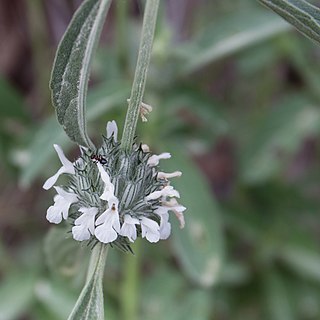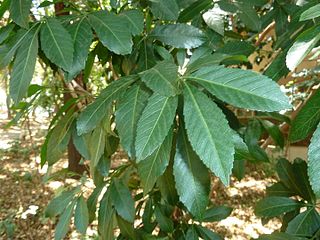
Curtisia dentata is a flowering tree from Southern Africa. It is the sole species in genus Curtisia, which was originally classed as a type of "dogwood" (Cornaceae), but is now placed in its own unique family Curtisiaceae.

Tulbaghia is a genus of monocotyledonous herbaceous perennial bulbs native to Africa, belonging to the amaryllis family. It is one of only two known genera in the society garlic tribe within the onion subfamily. The genus was named for Ryk Tulbagh (1699–1771), one time governor of The Cape of Good Hope.

Kniphofia is a genus of perennial flowering plants in the family Asphodelaceae, first described as a genus in 1794. The species are native to Africa. Common names include tritoma, red hot poker, torch lily and poker plant.

Disa is a genus of flowering plants in the family Orchidaceae. It comprises about 182 species. Most of the species are indigenous to tropical and southern Africa, with a few more in the Arabian Peninsula, Madagascar, and Réunion. Disa bracteata is naturalised in Western Australia, where the local name is "African weed-orchid."

Euclea, from the Greek eukleia meaning "glory and fame", denotes a group of flowering plants in the Ebenaceae or ebony family. They were described as a genus by Linnaeus in 1774. The genus includes evergreen trees and shrubs, native to Africa, the Comoro Islands and Arabia. Several species are used for timber, producing a hard, dark heartwood timber similar to ebony.

Carissa is a genus of shrubs or small trees native to tropical and subtropical regions of Africa, Australia and Asia. Until recently about 100 species were listed, but most of them have been relegated to the status of synonyms or assigned to other genera, such as Acokanthera.

Dietes is a genus of rhizomatous plants of the family Iridaceae, first described as a genus in 1866. Common names include wood iris, fortnight lily, African iris, Japanese iris and butterfly iris, each of which may be used differently in different regions for one or more of the six species within the genus.
Heywoodia is a genus of plants in the Phyllanthaceae first described as a genus in 1907. It contains only one known species, Heywoodia lucens, native to eastern, southeastern, and southern Africa.

Plectranthus is a genus of about 85 species of flowering plants from the sage family, Lamiaceae, found mostly in southern and tropical Africa and Madagascar. Common names include spur-flower. Plectranthus species are herbaceous perennial plants, rarely annuals or soft-wooded shrubs, sometimes succulent; sometimes with a tuberous base.

Aloidendron barberae, formerly Aloe bainesii and Aloe barberae, also known as the tree aloe, is a species of succulent plant in the genus Aloidendron. It is native to South Africa northwards to Mozambique. In its native climes this slow-growing tree can reach up to 60 feet (18 m) high and 36 inches (0.91 m) in stem diameter. Aloidendron barberae is Africa's largest aloe-like plant. The tree aloe is often used as an ornamental plant. Its tubular flowers are rose pink (green-tipped); it flowers in winter and in its natural environment is pollinated by sunbirds.

The white-throated robin-chat or white-throated robin is a species of bird in the family Muscicapidae. It is endemic to Botswana, Eswatini, Mozambique, South Africa, and Zimbabwe. Its natural habitats are dry savannah and subtropical or tropical dry shrubland.

Deinbollia oblongifolia is a shrub or small tree in the family Sapindaceae. It is commonly known as the dune soap-berry and is found in coastal vegetation from the Eastern Cape of South Africa, through KwaZulu-Natal to southern Mozambique and Eswatini. It is named after Peter Vogelius Deinboll (1783–1876), a Danish botanist and plant collector.

Englerophytum is a group of trees in the family Sapotaceae described as a genus in 1914.

Lumnitzera racemosa, commonly known as the white-flowered black mangrove, is a species of mangrove in the family Combretaceae. It is found on the eastern coast of Africa and other places in the western Indo-Pacific region. It has one accepted variety from the noniminate species, Lumnitzera racemosa var. lutea (Gaudich.) Exell.

Acrotome (horsefrights) is a genus of plants in the family Lamiaceae, first described in 1838. The genus is native to the southern part of Africa.

Syncolostemon (sagebushes) is a genus of plants in the family Lamiaceae, first described in 1838. It is native primarily to South Africa, with some species in other parts of sub-Saharan Africa, plus one species in India.
- Syncolostemon albiflorus(N.E.Br.) D.F.Otieno - Transvaal, Eswatini
- Syncolostemon argenteusN.E.Br. - KwaZulu-Natal
- Syncolostemon bolusii(N.E.Br.) D.F.Otieno - KwaZulu-Natal
- Syncolostemon bracteosus(Benth.) D.F.Otieno - widespread across much of sub-Saharan Africa
- Syncolostemon canescens(Gürke) D.F.Otieno - Angola, Botswana, Zimbabwe, Eswatini, South Africa
- Syncolostemon cinereum(Codd) D.F.Otieno & Retief - South Africa
- Syncolostemon comosus(Wight ex Benth.) D.F.Otieno - southern India
- Syncolostemon comptoniiCodd - Eswatini
- Syncolostemon concinnusN.E.Br. - Eswatini, South Africa
- Syncolostemon densiflorusBenth. - South Africa
- Syncolostemon elliottii(Baker) D.F.Otieno - Zimbabwe, Botswana, Transvaal
- Syncolostemon eriocephalusVerd. - Northern Province of South Africa
- Syncolostemon flabellifolius(S.Moore) A.J.Paton - Chimanimani Mountains of Mozambique + Zimbabwe
- Syncolostemon floccosus(Launert) D.F.Otieno - Namibia
- Syncolostemon foliosus(S.Moore) D.F.Otieno - Eswatini, South Africa
- Syncolostemon gerrardii(N.E.Br.) D.F.Otieno - South Africa
- Syncolostemon incanus(Codd) D.F.Otieno - Northern Province of South Africa
- Syncolostemon latidens(N.E.Br.) Codd - KwaZulu-Natal
- Syncolostemon linearis(Benth.) D.F.Otieno - Zimbabwe
- Syncolostemon macranthus(Gürke) Ashby - Drakensberg Mountains in South Africa
- Syncolostemon macrophyllusGürke - South Africa
- Syncolostemon madagascariensis(A.J.Paton & Hedge) D.F.Otieno - Madagascar
- Syncolostemon modestus(Codd) D.F.Otieno - Eswatini, South Africa
- Syncolostemon namapaensisD.F.Otieno - Mozambique, Tanzania
- Syncolostemon obermeyerae(M.Ashby) D.F.Otieno - Northern Province of South Africa
- Syncolostemon oritrephes(Wild) D.F.Otieno - Chimanimani Mountains of Mozambique + Zimbabwe
- Syncolostemon ornatus(S.Moore) D.F.Otieno - Chimanimani Mountains of Zimbabwe
- Syncolostemon parviflorusE.Mey. ex Benth. - Eswatini, South Africa
- Syncolostemon parvifolius(Codd) D.F.Otieno - Northern Province of South Africa
- Syncolostemon persimilis(N.E.Br.) D.F.Otieno - Northern Province of South Africa
- Syncolostemon petiolatus(Ashby) D.F.Otieno - Eswatini, South Africa, Mozambique
- Syncolostemon pretoriae(Gürke) D.F.Otieno - Eswatini, South Africa
- Syncolostemon punctatus(Codd) D.F.Otieno - Northern Province of South Africa
- Syncolostemon ramosus(Codd) D.F.Otieno - KwaZulu-Natal
- Syncolostemon ramulosusE.Mey. ex Benth. - KwaZulu-Natal, Cape Province
- Syncolostemon rehmannii(Gürke) D.F.Otieno - Northern Province of South Africa
- Syncolostemon rotundifoliusE.Mey. ex Benth. - KwaZulu-Natal, Cape Province
- Syncolostemon rugosifolius(M.Ashby) D.F.Otieno - Northern Province of South Africa
- Syncolostemon stalmansii(A.J.Paton & K.Balkwill) D.F.Otieno - Mpumalanga, Eswatini
- Syncolostemon stenophyllus(Gürke) D.F.Otieno - KwaZulu-Natal, Cape Province
- Syncolostemon subvelutinus(Gürke) D.F.Otieno - Northern Province of South Africa
- Syncolostemon teucriifolius(Hochst.) D.F.Otieno - Mozambique, Zimbabwe, South Africa
- Syncolostemon thorncroftii(N.E.Br.) D.F.Otieno - Northern Province of South Africa
- Syncolostemon transvaalensis(Schltr.) D.F.Otieno - Northern Province of South Africa
- Syncolostemon welwitschii(Rolfe) D.F.Otieno - Nigeria, Cameroon, Central African Republic, Zaire, Tanzania, Zambia, Angola

Euclea natalensis, the Natal guarri, is a dioecious African plant species of the family Ebenaceae. It occurs from Ethiopia and Somalia in the north, southwards to the Western Cape, South Africa. It has nectar and also contains pollen Its hirsute, leathery leaves have an opposite arrangement, and the flower sprays grow from the leaf axils. The spherical fruit appear from October to June.

Boscia foetida, commonly known as the stink shepherd's tree and the smelly shepherd's bush, is an evergreen shrub or tree that is native to the warmer and drier parts southern Africa. It is found in semi-desert and arid bushveld, and in the west it occurs commonly in areas which are otherwise sparsely wooded. It is known for the particularly unpleasant smell of its flowers which appear during early spring, to which its specific name foetida alludes. Its freshly cut wood likewise has an unpleasant smell, and has traditional medicinal and magical uses, for instance as a protection against lightning. In central Botswana the village of Mopipi is named after this species.

Allophylus natalensis, commonly known as the dune false crowberry or dune false currant, is a species of plant in the genus Allophylus native to south-eastern Africa.

Coffea racemosa, also known as racemosa coffee and Inhambane coffee, is a species of flowering plant in the family Rubiaceae. It has naturally low levels of caffeine, less than half of that found in Coffea arabica, and a quarter of that in Robusta coffee.
























